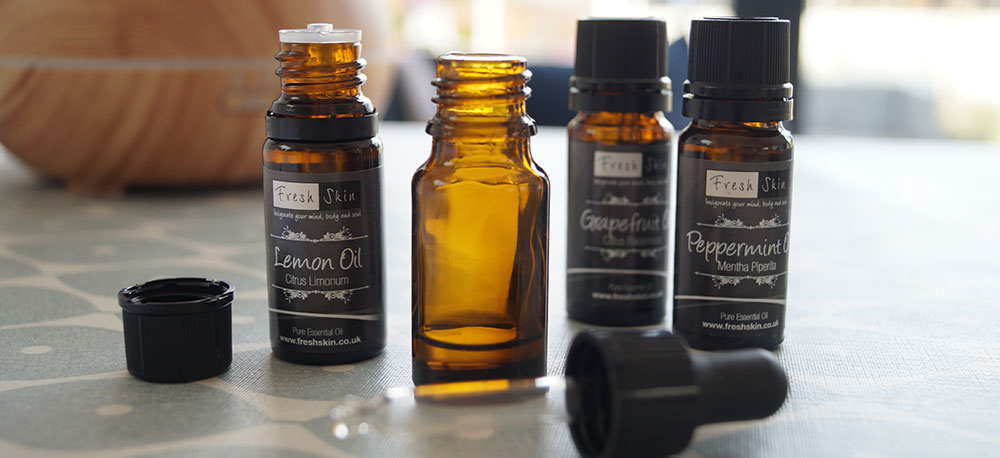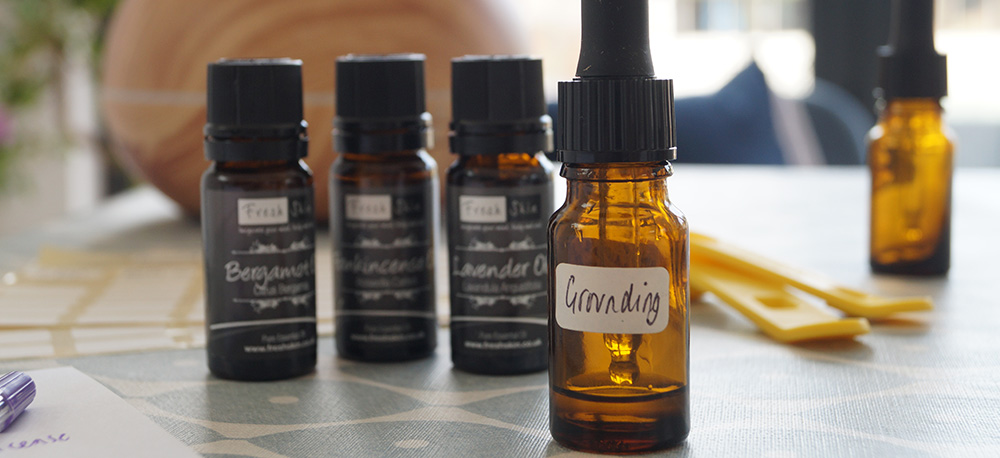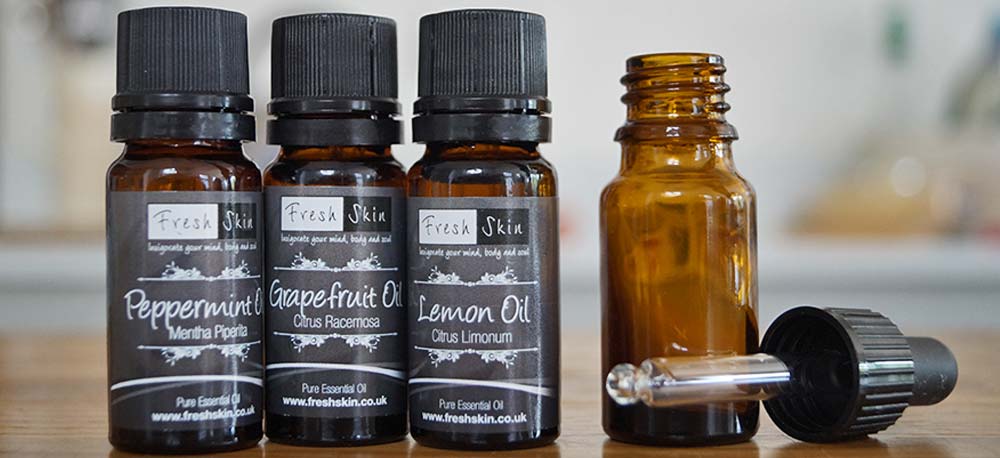Aromatherapy, Essential Oils, Fragrance Oils, Fragrances, How To
Essential Oils Blending Guide
Create your own beautiful oil blends to use in homemade beauty products, candles or simply in a diffuser with our easy to follow guide to blending essential oils.
Learning how to make your own essential oil blends may seem like an overwhelming prospect. An internet search will throw up hundreds of detailed and complicated guides which often can be confusing and difficult to follow. That’s why we decided to put together this really simple, easy to use guide.
Why do people blend essential oils?
This is the first question you might be asking yourself. If you’ve already got a favourite essential oil fragrance, like lavender, that you just love adding to your homemade products, then the idea of blending it with other oils might seem a waste of time. However, creating blends can be a really fun way of making your own unique and signature fragrances that draw in notes from other oils and actually add to, rather than take from, your favourite.
When essential oils blend they actually start to work together in synergy, complimenting each other by balancing out the weaker parts of each compound. So, get your lab coat on, grab a notebook and play aromatherapist for the day by trying to find the right balance between oils and experimenting with different volumes of each.
Three ways of grouping essential oils
When it comes to blending essential oils, there are three main ways that they can be categorised:
By effect
Lift your mood or get grounded
By fragrance
Floral, citrus, spicy, woody…
By note
Top, middle or bottom?
By identifying which essential oils fall into each category, it’s easy to start creating combinations that you can be confident will work well together.

Blending essential oils by effect
Let’s start by looking at properties of essential oils and the impact each might have on your mood. This is a useful starting point for anyone wanting to create a blend that serves a specific purpose, whether it’s an energising soap for the morning shower or a relaxing diffuser blend to help you unwind.
Because we want this to be a relatively simple guide to essential oil blending we’re not going to get too hung up on the individual therapeutic benefits of each oil. Search our site for any specific essential oil and you’ll find some great information about how it can be used and what type of effect it can have on your mood.
Instead, we’ll categorise our essential oils into 4 key groups:
Energising
Oils to kick-start your day
Bergamot, Citronella, Grapefruit, Lemon, Lemongrass, Lime, Sweet Orange, Coriander, Black Pepper, Cinnamon Leaf, Clove, Cypress, Petitgrain, Pine Needle, Basil, Clary Sage, Eucalyptus, Spearmint, Peppermint, Rosemary, Sage, Tea Tree
Relaxing
Oils to help you unwind
Bergamot, Rose Geranium, Geranium, Lavender, Palmarosa, Ylang Ylang, Nutmeg, Cedarwood Atlas, Frankincense, Patchouli, Vetiver, Clary Sage, Sage, Red Thyme
Cleansing
Cleanse your mind and body
Citronella, Grapefruit, Lemon, Lime, Sweet Orange, Nutmeg, Oregano, Juniper Berry, Patchouli, Peppermint
Grounding
Come back down to earth
Bergamot, Sweet Orange, Rose Geranium, Geranium, Lavender, Coriander, Black Pepper, Clove, Oregano, Cedarwood Atlas, Frankincense, Sandalwood, Vetiver, Chamomile, Marjoram, Spearmint, Red Thyme
If you’re just starting out or wish to keep things easy we recommend combining oils from the same family in equal amounts. Alternatively, you may wish to combine cleansing and energising oils, or relaxing and grounding oils, which serve a similar purpose.
Example blends for improving your mood
A couple of our house favourite essential oil blends for energising in the morning and unwinding later in the day are below. These super simple blends are perfect for adding to a diffuser:
Energising blend
1 part Lemon + 1 part Grapefruit + 1 part Peppermint
Relaxing blend
1 part Bergamot + 1 part Patchouli + 1 part Ylang Ylang

Blending essential oils by fragrance
For many, essential oils are purely a wonderful way to fragrance the home and their homemade products – and that’s absolutely fine by us! Broadly speaking, essential oils can be divided into countless fragrance categories but to keep things simple we’re going to focus on 5 core fragrance groups that our most popular oils fit into: Citrus, Floral, Herbal, Spicy, Woody.
Generally, oils from the same fragrance group will blend well together, but that’s not to say you can’t combine different types of fragrance. Ultimately, what works and what doesn’t is completely objective and based on your personal preference, however blending oils from the same fragrance family or complementary categories is a great place to start.
If you decide to start blending different fragrance families, here’s a handy guide to which fragrances go well together:
Citrus – Blends well with Floral, Woody, Herbal & Spicy
Bergamot, Citronella, Grapefruit, Lemon, Lemongrass, Lime, Neroli, Sweet Orange
Floral – Blends well with Citrus, Spicy & Woody
Rose Geranium, Geranium, Lavender, Palmarosa, Ylang Ylang
Herbal – Blends well with Woody & Spicy
Coriander, Black Pepper, Cinnamon Leaf, Clove, Nutmeg, Peppermint
Spicy – Blends well with Floral, Woody & Citrus
Cedarwood Atlas, Cypress, Frankincense, Juniper Berry, Patchouli, Petitgrain, Pine Needle, Sandalwood, Vetiver
Woody – Blends well with Floral, Citrus, Herbal & Spicy
Basil, Chamomile, Clary Sage, Eucalyptus, Marjoram, Spearmint, Oregano, Rosemary, Sage, Tea Tree, Red Thyme
When blending by fragrance for the first time, we recommend sticking to a simple balanced approach. Choose oils from the families that blend well with each other and use equal amounts of each oil to get a nice harmonious blend. As you start to recognise distinctive scents and develop favourites, you can start to tinker with your fragrance blends by adding a few extra drops of one oil or another.
Example fragrance blends
If you wanted to make a simple fragrance based blend you may choose the following combinations:
Floral/Spicy blend
1 part Lavender + 1 part Geranium + 1 part Sandalwood
Citrus/Herbal blend
1 part Sweet Orange + 1 part Grapefruit + 1 part Lemon + 1 part Peppermint

Blending essential oils by note
The third and final way to group essential oils is by their individual fragrance note. Creating a blend from notes that balance one another is a simple way to create winning blends everytime. Because essential oils evaporate at different speeds, a blend consisting of differing notes will provide a fragrance that changes over time – much like your perfume or aftershave does.
Like a musical scale, essential oil fragrances that fade the quickest are classified as ‘top notes’, next are the ‘middle notes’ and, finally, the oils that take the longest are ‘base notes’.
Top note essential oils are the lightest and the first ones you’ll smell, they’re generally floral or citrusy. Base notes are deeper, heavy scents which will ground your blend and help it last longer. Base notes are typically found in woody oils. Finally, middle notes bind the two together and are commonly derived from whole herbs and spices.
Bergamot, Citronella, Grapefruit, Lemon, Lemongrass, Lime, Sweet Orange, Petitgrain, Pine Needle, Basil, Eucalyptus, Spearmint, Sage
Lavender, Rose Geranium, Geranium, Palmarosa, Coriander, Cinnamon Leaf, Clove, Nutmeg, Cypress, Juniper Berry, Chamomile, Clary Sage, Marjoram, Oregano, Rosemary, Tea Tree, Red Thyme
Ylang Ylang, Black Pepper, Cedarwood Atlas, Frankincense, Patchouli, Sandalwood, Vetiver, Peppermint
The 30/50/20 rule
If blending by note is the way you want to go then the 30/50/20 rule is a simple to use and easy way of finding the right balance in your blend. Put simply, your blend will be made up from 30% top note oils, 50% middle note oils and 20% base note oils. So if your blend was 10 drops in total, you’d use 3 drops of a top note, 5 of a middle note and 2 of a base note. We told you it was simple!
30% Top + 50% Middle + 20% Base
If you want to use more than three essential oils in your blend, you can always combine two different oils with the same note by making sure that the final ratios remain the same. For instance:
20% Top A + 10% Top B + 50% Middle + 20% Base
30% Top + 30% Middle A + 20% Middle B + 20% Base
And so on and so forth. If you do decide to use multiple essential oils for any note, we recommend selecting them from the same fragrance family to ensure a harmonious blend.
Example note based blends
Blending by note is when the fun really starts. Try to take on board the other properties listed to make sure you get a beautifully balanced blend. For example:
Get grounded:
3 parts Bergamot (T)+ 5 parts Lavender (M) + 2 parts Frankincense (B)
Wake up and go:
2 parts Lemon (T) + 1 part Spearmint (T) + 3 parts Lavender (M) + 2 parts Geranium (M) + 2 parts Sandalwood (B)
If you’ve stayed with us this far then you’re just about ready to go. To help get you started, we’ve created a table featuring all of our most popular essential oils for blending including their fragrance family, the effect they can have mood and their corresponding note.
Essential oil properties
Essential Oil |
Fragrance |
Effect |
Note |
| Bergamot | Citrus | Energising, Relaxing, Grounding | Top |
| Citronella | Citrus | Energising, Cleansing | Top/Middle |
| Grapefruit | Citrus | Energising, Cleansing | Top |
| Lemon | Citrus | Energising, Cleansing | Top |
| Lemongrass | Citrus | Energising | Top |
| Lime | Citrus | Energising, Cleansing | Top |
| Sweet Orange | Citrus | Energising, Cleansing, Grounding | Top |
| Rose Geranium | Floral | Relaxing, Grounding | Middle |
| Geranium | Floral | Relaxing, Grounding | Middle |
| Lavender | Floral | Relaxing, Grounding | Top/Middle |
| Palmarosa | Floral | Relaxing | Middle |
| Ylang Ylang | Floral | Relaxing | Middle/Base |
| Coriander | Spicy | Energising, Grounding | Middle |
| Black Pepper | Spicy | Energising, Grounding | Middle/Base |
| Cinnamon Leaf | Spicy | Energising | Middle |
| Clove | Spicy | Energising, Grounding | Middle |
| Nutmeg | Spicy | Relaxing, Cleansing | Middle |
| Cedarwood Atlas | Woody | Relaxing, Grounding | Base |
| Cypress | Woody | Energising | Middle |
| Frankincense | Woody | Relaxing, Grounding | Base |
| Juniper Berry | Woody | Cleansing | Middle |
| Patchouli | Woody | Relaxing, Cleansing | Base |
| Petitgrain | Woody/Citrus | Energising | Top |
| Pine Needle | Woody | Energising | Top |
| Sandalwood | Woody | Grounding | Base |
| Vetiver | Woody | Relaxing, Grounding | Base |
| Basil | Herbal | Energising | Top |
| Chamomile | Herbal | Grounding | Middle |
| Clary Sage | Herbal | Energising, Relaxing | Middle |
| Eucalyptus | Herbal | Energising | Top |
| Marjoram | Herbal | Grounding | Middle |
| Spearmint | Herbal | Energising, Grounding | Top |
| Oregano | Herbal | Cleansing, Grounding | Middle |
| Peppermint | Herbal | Energising, Cleansing | Base |
| Rosemary | Herbal | Energising | Middle |
| Sage | Herbal | Energising, Relaxing | Top |
| Tea Tree | Herbal | Energising | Middle |
| Red Thyme | Herbal | Relaxing, Grounding | Middle |
Formulating your blend
Now you know the basics of essential oil blending, it’s nearly time to start creating your own blends but first, put the kettle on, grab a pen and notepad and spend a moment planning your first combinations.
Things to think about
- How will this blend be used?
- What effect do I want it to have?
- Where and when will it be used?
- Are there any oils I specifically want to include?
Identifying how, why and where your blend will be used is a great way of narrowing down which oils you are going to use. And if you know there’s one oil you just have to use, then that will help you create a shortlist of what to blend with it.
Example blends
In our Melt and Pour Soap Guide, we wanted a soap for the bathroom which would cleanse whilst also helping us to unwind at the end of the day. We chose grapefruit oil for our top note because of its cleansing properties and gorgeous citrus fragrance.
Using the table above we were quickly able to identify which oils would be most suitable for blending with grapefruit oil. Knowing floral oils blend well with citrus oils, we chose calming lavender essential oil as our middle note and ylang ylang oil for our base.
Once you’ve drafted your blend out on paper, and decided what proportions of which oil you’ll be using it’s time to start blending.

Time to start blending
Now that we’ve covered the three key approaches to blending essential oils, it’s time to start creating your own combinations.
What you’ll need
Storage
When blending essential oils, it’s important to be patient and allow your blend time to rest for a few days. This allows the essential oils to combine and the fragrance to develop.
To store your blends you’ll need a few amber bottles. Amber glass helps to keep essential oils from deteriorating and protects their aromatic and therapeutic properties.
Testing your blend
If you want to get an idea of how your blend is going to smell, you can add a drop of each oil to a fragrance strip or cotton wool ball. Roughly imitate the ratios that will be used in your blend (i.e. 1 drop of this, 2 drops of that) then hold the mix a little distance from your nose, close your eyes and test the fragrance. If you’re not completely happy with the result, you could consider adjusting the quantities until you get the desired scent.
How many drops of essential oils to use per blend
It’s worth thinking about how much of your blend you’re going to need before you start. To begin with we recommend making relatively small batches of your blends while you perfect the fragrance.
If you plan to add your blend to a carrier oil for massages, skin lotions or to use in the bath you’ll need some kind of carrier oil or dispersing agent. Alternatively, if you’re using your blend in a candle, some soap or just in a diffuser, you’ll want to make sure you’ve made enough.
Rule of thumb:
1ml of essential oils is about 20 drops. For a 100g bar of soap, you’ll ideally have around 2-3ml of your blend to stay within the recommended 3% dilution rate. That’s 40 – 60 drops for one bar.
For skin lotions and massage oils you’ll likely need around 15 drops per 30ml of carrier and in a diffuser you’ll want to use between 5-10 drops per 100ml of water.
Begin Blending
Once you’re happy with your recipe and how many drops to start with, it’s time to start blending. After all of this preparation, the actual process of blending your oils will seem rather quick:
4 simple steps
01
Get your essential oils ready
02
One at a time, add the desired number of drops of each oil to your first amber bottle
03
Give your blend a test sniff to check your happy with the balance – remember your fragrance will change over time so resist the urge to tinker too much
04
Lid your blend and label it – try to include the ingredients and quantities for future reference
That’s it! Store your blend away from daylight for at least 48 hours and return to it once it’s had a chance to rest.
Top tips for successful blending
While there is a lot to consider when blending essential oils, the process is actually very simple. A few basic precautions and a bit of planning makes it easy, safe and rewarding. Once you’ve got to grips with the concept of fragrances, notes and the impacts on mood, the opportunities for creating gorgeous essential oil blends are endless.
If using in the bath, ensure you use an appropriate dispersing agent (try our Jojoba Oil or Sweet Almond Oil).
Top blending tips
- As a rule, never exceed the recommended 3% dilution rate
- Some oils have a dilution rate that is lower than 3%. In a blend it’s rare that any single oil will exceed their dilution rate, but always check the guidelines on the bottle and your recipe to be sure
- Make sure you’ve planned your blend and made some notes before you begin mixing
- Leave your blend for 48 hours before using
- Store your blends in dark bottles to preserve the essential oils
- Never use essential oils orally or directly on the skin
Pre-blended oils
Sometimes you may decide you haven’t got the time or desire to perfect the blend you need. In those instances, that’s where our brilliant fragrance oils come in. Pre blended by the experts at Freshskin Beauty, this huge collection of aromas includes gorgeous seasonal mixes and everything from retro sweet fragrances to beautiful perfume blends.
Rich and complex, these great pre-made fragrance blends are a great time saver and an easy way to create wonderful smelling soaps, skin lotions and beauty products.


